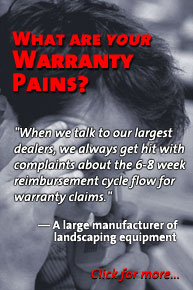March 31, 2003 |
ISSN 1550-9214 |
Don't TREAD On Me:Part 1: Because of the Firestone tire fiasco, automakers must begin compiling quarterly reports on consumer complaints and warranty claims beginning tomorrow.by Eric Arnum, Editor
Never heard of the TREAD Act? It's a new U.S. law that legislators said was prompted by the slow pace of Bridgestone/Firestone's recall of 6.5 million tires used primarily on Ford Explorer vehicles, and the deaths of more than 100 people in accidents blamed on the failure of those tires. But the TREAD Act includes numerous additional provisions that involve everything from tire pressure sensors to child restraint seats. It is a sweeping piece of legislation that requires large manufacturers to report a wide variety of warranty, customer service, and legal data to the federal government, in the hopes that the National Highway Traffic Safety Administration's data analysis tools will allow it to detect patterns in the data that point to a safety defect of some kind. Helps Spot Defects Earlier?Furthermore, because the NHTSA believes it took as much as two years longer than was necessary for the Firestone tire problem to result in a recall, the TREAD Act rules are written in a way that requires large manufacturers to automatically report everything from minor complaints about unhelpful staff to major lawsuits that follow actual accidents and deaths. It's then up to the government to decide if the problems described are safety-related or not. So it will no longer be up to the manufacturer to determine relevance or to detect patterns. The TREAD Act, introduced into Congress three years ago as H.R. 5164, and signed into law by President Bill Clinton on Nov. 1, 2000 as Public Law 106-414, requires manufacturers of motor vehicles and equipment sold in the U.S. to submit quarterly reports to the NHTSA that summarize all claims made against them for incidents that involve deaths or serious injuries, property damage data, communications to customers and others, information on incidents that happen in a foreign country to vehicles that are substantially similar to vehicles sold in the U.S., and other information that helps the agency identify potential safety-related defects. Early Warning Reporting SystemThe section of highest interest to Warranty Week readers is probably the provisions for an Early Warning Reporting (EWR) system, embodied in Section 3(b) of the Act. That section requires manufacturers to incorporate warranty claims data into the quarterly reports, which must be submitted electronically to NHTSA as multi-tab Microsoft Excel spreadsheets.
Mailed CD-ROMs will not be accepted, because anthrax-screening equipment now in place at the Dept. of Transportation's mail processing site reportedly can destroy CD-ROM data. Paper reports also will not be accepted, because frankly, this is the 21st Century -- the age of electronic government. Helpful ResourcesOn its Web site, NHTSA has posted a downloadable collection of blank report samples in the form of Excel spreadsheet templates that fulfill the EWR requirements of the TREAD Act. In the Federal Register for July 10, 2002 (Vol. 67, No. 132, Pages 45821-45883), NHTSA published a detailed discussion of the final rule for TREAD Act EWR provisions. Notably, the NHTSA EWR rule divides the market into two groups:
Companies that fall into the first group must now report information related to all incidents that involve deaths, injuries, or property damage. They also must report quarterly on the number and type of consumer complaints, warranty claims, and field reports received from dealers, fleet operators, authorized service centers, employees, and others. In addition, they must report volume production statistics, so the NHTSA can compute the number of claims per unit of production. Manufacturers in the second group need to submit quarterly statistics and reports related only to deaths, which hopefully lightens the burden of compliance for them. The first reporting period covered by the EWR rule is the second quarter of 2003, which runs from April 1 to June 30. Reports are normally due 30 days after the end of each quarter, except during an introductory period that lasts through the three remaining quarters of 2003. For these first three filing deadlines, NHTSA is granting an extra-long 60-day grace period. This means that the reporting deadlines for 2003 are Aug. 31, Dec. 1 (Nov. 30 is a Sunday), and Feb. 29, 2004 (it's a leap year), while the deadlines for the four quarters of 2004 will come at the end of April, July, and October 2004, plus January 2005. Three Years of Historical Data Sought
Not everyone is pleased by the TREAD Act's basic assumption that an automaker or a tire manufacturer can no longer be relied upon to report defects in a timely manner. TREAD is at its heart a response to the Firestone/Ford Explorer episode, under which the old system worked too slowly to save lives. NHTSA estimates that had a recall been initiated on Aug. 9, 1998 instead of on Aug. 9, 2000, it might have saved the lives of 143 out of a total of 192 who died as a result of alleged tread separation. However, in its zeal to save lives, NHTSA is requiring large manufacturers to submit more data than they have in the past, absorbing the cost of compliance. This creates what Washington calls an "unfunded mandate," which is what happens when the government legislates procedures without appropriating money to pay for them. In this case, NHTSA believes the costs are very slight (less than 1% of total tire industry revenue), while industry groups believe compliance costs could be large enough to necessitate price increases of 5% or more.
It also has now summarized those views in a PDF file posted on its Web site. Basically, the TIA believes that the TREAD Act's requirement that virtually any consumer problem must be reported will force manufacturers to redefine what constitutes a problem. Becky MacDicken, the TIA's director of government affairs, said that for instance, in cases where it's not entirely clear whether a tire's failure was caused by a manufacturing defect, a road hazard, or by the consumer's own negligence, the dealer acting as an agent for the manufacturer is not going to be as accommodating as they might have been in the past. "The manufacturers are going to have to report everything to the government," she said. "Because of that, the manufacturers could very easily pull back on a lot of the warranties they offer to the dealers. I think we're going to see a downshift in those programs." While she doesn't see TREAD-induced cutbacks in the average number of years/miles a tire is covered, she does predict more strictly-enforced rules over what constitutes an allowable return. Tightening up on warranty terms and conditions cuts down on warranty claims. By more strictly enforcing the allowable reasons for a return, the company decreases the number of returns, and therefore the amount of government paperwork. However, such rudeness might drive up consumer complaint volumes too. Either way, customer satisfaction is reduced. Dealers might continue to accept borderline-legitimate warranty claims they know the manufacturer will no longer honor. For instance, if a repeat customer arrives with a tire that was clearly damaged by underinflation, does the dealer reject the claim and jeopardize future business, or do they accept the claim to keep them happy? "It's going to depend on the dealers. They could easily decide to eat the cost of those adjustments, if it's a customer that's been coming to them for 20 years," MacDicken said. "There may be other places where if they don't know the customer, and they're not as concerned about losing a repeat customer, they may say 'I'm sorry, we're not adjusting this tire, because it's obvious to us that you've driven it underinflated.'" MacDicken said the TIA is working on a program called the "Tire Wear and Out of Service Guide" that will help direct dealers to making a proper decision as to whether a tire has been run underinflated or if it's actually a problem at the manufacturer level. "We hope that will assist dealers in making that determination on what is wrong with the tire," she said. "Most dealers out there would rather not fight with their customers and they would make the adjustments. But if they have something in their hands they can show the person, and say 'look, this is an obvious pattern from a tire being run underinflated, and that is therefore something you caused. And therefore we are not adjusting your tire.' It will help them a lot." TREAD Compliance CostsSo what will this cost? Will it raise the cost of a tire by 5% or 50%? It depends who you ask. The government, which has extensive reporting requirements of its own for what are called "unfunded mandates" if those mandates will cost more than $100 million to implement, has unsurprisingly determined that the TREAD Act's EWR provisions will cost much less than that amount. In dollar terms, NHTSA is predicting it will cost much less than 1% of tire industry revenue to implement EWR. Others disagree. Kevin Prouty of AMR Research estimated in a Dec. 23, 2002 article that initial compliance with TREAD Act reporting mandates will run a typical manufacturer $3 to $10 million in labor and systems. Annual costs thereafter will fall into a range of $1 to $2.5 million, he wrote. "These costs include the squad of lawyers needed for validating compliance, IT personnel to implement and maintain systems, and the administrative staff for collecting and entering data," Prouty added. Individual manufacturers have given estimates to the government that are slightly lower. Volvo Trucks North America Inc. sent a letter to NHTSA in March 2001 in which they mention that the cost per year for storing warranty data on their servers is around $1.3 million. American Honda Motor Co. Inc. estimates its first-year TREAD Act compliance costs at $1.5 million, plus an ongoing cost of $600,000 for each subsequent year. April Fools Joke
Actual cost depends heavily on the format in which field reports, customer complaints, and warranty data have been kept. If a company's warranty claims and adjustment data has been kept in a Microsoft Excel format for the past couple of years, compliance costs are likely to be on the low side. If it's all on paper in some boxes stacked in a storage closet, the cost of all that data entry could be incredibly high. Cost/Benefit AnalysisIn contrast, NHTSA calculates total industry costs for all manufacturers at $70.35 million for the first year and $1.72 million for each subsequent year. The first-year industry cost includes $65.3 million for computer setup, plus $3.3 million for the preparation of the 12 historical quarterly reports. In its research, NHTSA counts 16 manufacturers of light vehicles; 31 makers of medium/heavy vehicles and buses; and 12 motorcycle manufacturers that are covered by the TREAD Act. NHTSA estimates that around 69% of these total industry costs will be shouldered by the light vehicle manufacturers, 12% by makers of medium/heavy vehicles and buses, and 9% by motorcycle manufacturers. NHTSA also said it believes the TREAD Act's EWR system will benefit manufacturers by reducing product recall costs by as much as $9 million per year, primarily by alerting them to defects earlier so they can stop production of vehicles that will later require a recall. NHTSA estimates that the EWR system will allow it to open investigations 12 months sooner than before, and to initiate recalls three months earlier than is now typical. Tire Industry StatisticsModern Tire Dealer estimates 2002 U.S. shipments of tires at 291 million units for passenger cars and light trucks, and at 19 million units for medium and heavy trucks. In dollar terms, tire revenue for passenger cars and light trucks topped $16.5 billion in 2002, while medium and heavy truck tires brought in an additional $4.4 billion. Notably, the $53.49 median retail price the magazine found for a typical passenger car tire was virtually unchanged from both 1995 and 1985 levels. Most observers agree that because of the TREAD Act, tire prices will soon go up. "Over the last 40 years tire prices, when indexed for inflation, have not risen at all," MacDicken said. "I think for the first time in 40 years, people are going to start seeing prices raised. The manufacturers can't absorb these costs. Neither can the dealers or wholesalers. So it's going to be passed on to the consumer." IT consultants, many of whom are still recovering from the post-Y2K market doldrums and the dot-com bust, stand ready to assist manufacturers with compliance issues. And surprisingly, although the first reporting period begins tomorrow, some manufacturers are just getting started now. TREAD Consulting Practices Emerge
Compliance Assessments
"We give them an actual process," she said. "What we're finding is a lot of companies have something for warranty, even if it's very basic, like an Excel spreadsheet. But they don't have all the other pieces, such as consumer complaints. So we provide data entry screens on our engine as well, where people can key in the data directly. And we collect through those screens what they must have for TREAD compliance, and also what they need to make sense of the data internally." In many ways the April 1 deadline reminds people of the run-up to Y2K, not only in its impact on systems, but also in the amount of fear and loathing it induces among system operators. "I'm finding as I'm going around doing assessments in particular, that people are very scared of it. But when I talk to them about what it really means, and what they really need to do, they calm down and they see that it's something that actually is manageable," Grant told Warranty Week. Never Been BusierGrant added that she was a bit surprised by how many manufacturers waited until now to begin planning for compliance. "In the last three to four weeks, I would say the activity has picked up significantly as people became aware of that April 1 deadline," she said. "We expected the 'bubble' to be January or February of this year. In fact, it is just building now. I am traveling all the time, and the phone is ringing constantly."
| ||||||||||||||||||||||||||||||||||||||||||||||||||
| ||||||||||||||||||||||||||||||||||||||||||||||||||


 This year, April 1 is not merely a day for foolish pranks. It's also the first day of the second quarter, which means certain provisions of the Transportation Recall, Enhancement, Accountability and Documentation (TREAD) Act go into effect tomorrow.
This year, April 1 is not merely a day for foolish pranks. It's also the first day of the second quarter, which means certain provisions of the Transportation Recall, Enhancement, Accountability and Documentation (TREAD) Act go into effect tomorrow. However, NHTSA expects that the procedures required for TREAD Act compliance may actually help manufacturers spot defects earlier, and perhaps save some money on both lawsuits and recall/warranty expenses.
However, NHTSA expects that the procedures required for TREAD Act compliance may actually help manufacturers spot defects earlier, and perhaps save some money on both lawsuits and recall/warranty expenses. NHTSA said it prefers that submissions be made as file uploads to a secure Web site, although shorter files with lengths of 5 Megabytes or less may also be emailed as file attachments.
NHTSA said it prefers that submissions be made as file uploads to a secure Web site, although shorter files with lengths of 5 Megabytes or less may also be emailed as file attachments. Larger manufacturers also are required to submit statistics to the NHTSA by Sept. 30 on the number of warranty claims and the number of field reports processed during each of the last 12 quarters. This will enable the NHTSA to create a baseline for the number of incidents that will help it better identify abnormal increases in the future. For motor vehicles, the 12 historical quarterly reports must cover warranty claims and field reports regarding all vehicles manufactured since the 1994 model year began. For tires and child restraints, the historical reports must cover claims regarding product manufactured since April 1, 1998.
Larger manufacturers also are required to submit statistics to the NHTSA by Sept. 30 on the number of warranty claims and the number of field reports processed during each of the last 12 quarters. This will enable the NHTSA to create a baseline for the number of incidents that will help it better identify abnormal increases in the future. For motor vehicles, the 12 historical quarterly reports must cover warranty claims and field reports regarding all vehicles manufactured since the 1994 model year began. For tires and child restraints, the historical reports must cover claims regarding product manufactured since April 1, 1998. The Tire Industry Association made its views known regarding the TREAD Act's EWR provisions in comments filed with NHTSA on Feb. 4, 2002.
The Tire Industry Association made its views known regarding the TREAD Act's EWR provisions in comments filed with NHTSA on Feb. 4, 2002.







